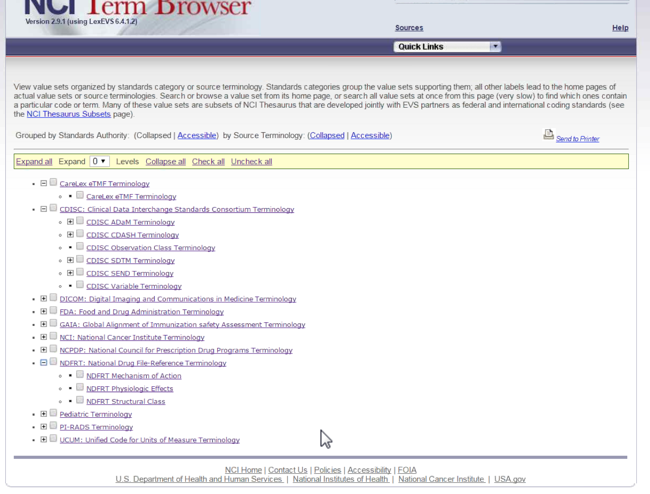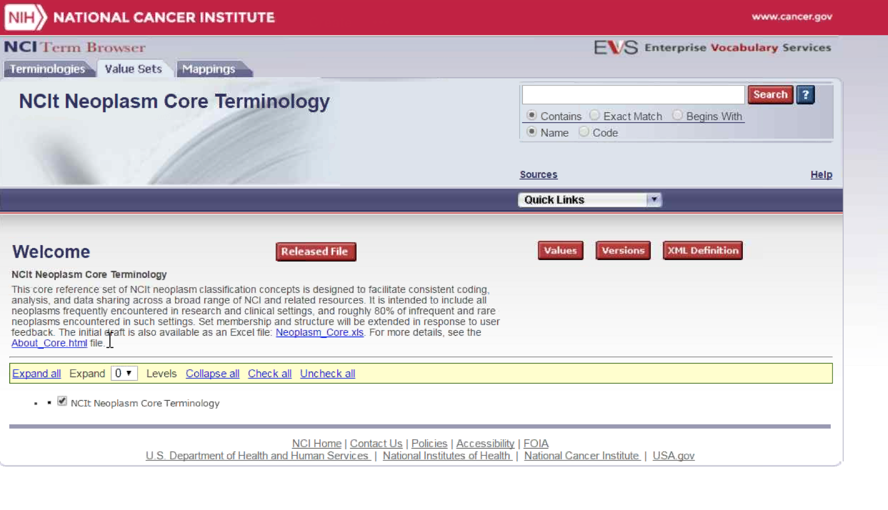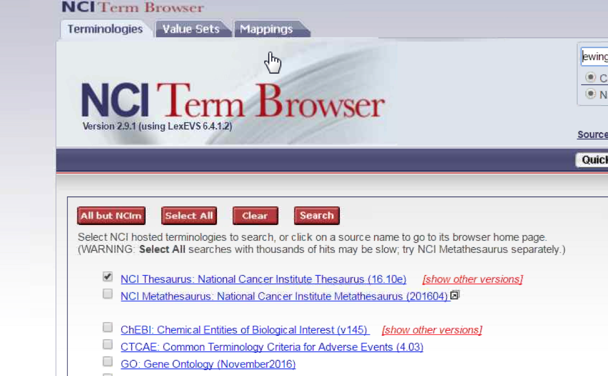Author: Craig Stancl, Scott Bauer, Cory Endle
Email: craig.stancl2@nih.gov, scott.bauer@nih.gov,
Team: LexEVS
Contract: 16X237
Client: NCI CBIIT
National Institutes of Heath
US Department of Health and Human Services
The purpose of this document is to document the technical face to face meeting details between the NCI and the LexEVS Team.
2016 November/December Face-to-Face Meeting Notes
Wednesday, November 30th, 2016
| Time | Location | Topics | Participants |
|---|---|---|---|
| 9:00 AM - 10:00 AM | 4W030 | User Group Discussion
| CTRP, caDSR, GDC |
Attendees: Larry, Jason, Kim, Craig, Scott, Cory, John, Liz, Sima, Rui, Natalia, Tracy, Sana, Tin, Gilberto
Discussion Points:
- caDSR Team represented by Sima, Natalia, Vikram
- caDSR Applications that use EVS
- Sentinel - Alerts for concepts, job that does concept clean up (compares concepts)
- Curation tooling - links to concepts, and search results.
- CDE Browser - Concepts used from search results.
- Semantic integration workbench - concepts used from search results
- CDEs
- Utilize the NCIT, NCI meta,
- Look into NCIT - will use the concept to describe the CDE.
- Organizing concepts to build CDE terminology.
- CDEs are used for forms (permissible values on forms)
- Tooling hasn't changed or been replaced.
- Currently use JARS and put in /lib
- Using Remote API today.
- Recently removed EJB
- Need to consider architecture in the future.
- MDR is planning to architect a solution moving forward.
- Currently searches are restricted to preferred terms.
- Building data element - definitional information, preferred name
- Existing CDE - pull back perferred name.
- Current Tooling Issues
- Need to have a data load completed to PROD.
- Confirmed data load and ready once things move to production.
- New LexEVS Jars will be included in next release.
- Remote API Architecture
- Issues
- Replacement of JARS
- Serialization of objects.
- Issues
- Proposed Architecture?
- REST-ful API
Decision Points:
- caDSR to provide list of what is currently used in the Java API
- EVS team to provide feedback as to how to do things better.
- EVS team to ensure that if REST-ful API is created, functionality to be prioritized.
| Time | Location | Topics | Participants |
|---|---|---|---|
| 10:00 AM - 11:00 AM | 4W030 | RESTful API Discussion
|
Attendees: Larry, Jason, Kim, Craig, Scott, Cory, John, Liz, Sima, Rui, Natalia, Tracy, Sana, Tin, Gilberto, Jacob
Discussion Points:
- Browser use cases reviewed.
- Additional cases
- History - the browser currently uses.
- Security - for Medra or other licensed vocabularies.
- May be able to use CTS2 APIs, but may need to have separate REST-ful services for customized/specialized content.
- Current browser wouldn't use REST services.
- Unknown coverage for REST possibilities. So additional investigation required.
- Additional cases
- Previous F2F considerations.
- Custom Lucene may need to be provided for clinical trials.
- Group Value Sets - may be useful.
- Restrict to Properties - need to better understand this usecase.
- History - suggested by the CTRP but has some requirements in scope of the Browser.
- Graph and Association
- No need from caDSR
- Additional requirements
- Bulk Download
- ability to download full or part of a complete terminology.
- Bulk Download
- Align rest calls to support Moonshot API services.
- Make others aware services are available.
- Tracy suggested to look at Data.gov
- Browser team not going to use REST at this time
- caDSR not going to use REST at this time.
Decision Points:
- Identify Moonshot Clinical Trial API services to be supported by REST services.
- Identify ways to promote REST services.
- Identify possibilities of participating in Data.gov
| Time | Location | Topics | Participants |
|---|---|---|---|
| 11:00 AM - 12:00 PM | 4W030 | Triple store/RDF Discussion
|
Attendees:
Discussion Points:
- There is a pilot ongoing to review triple stores
- selected 3 triple stores (StarDog, Allegrograph (http://allegrograph.com/), Viritouso) and have been working for the past 6 months
- evaluations covering restricting operations, loading data, performance testing, examine security (secured and anonymous access via proxies)
- nature of queries haven't been as representative of what is needed for production.
- more focus on real use queries.
- operations - hosting model not supported by CBIIT - so no support. (ie, patching support not provided)
- all can be queried with standard SPARQL
- will still want REST services available to the end users.
- Transition to SPAQRL gives raw access to the data (unlike API)
- However, you need to understand the data - and this could differ from endpoint to endpoint.
- What do TripleStores provide - that differ (better than) LexEVS
- Representation of Hierarchy
- Level of expressivity
- 3 use cases for triplestore evaluation:
- Expressivity (reasoning support)
- Linked open data
- use vocabulary as a "glue" between different data repositories. Ability to "join" distributed repositories.
- Closer integration of vocabulary and meta data (part of the MDR).
- Report writer now uses the triple store
- Loading of Value sets take much less time
- Access of Value Sets is better, but not hugely different.
- Need to determine where Triple Store is better and where LexEVS is better.
Decision Points:
- Investigate where Triple Store usage may augment LexEVS.
| Time | Location | Topics | Participants |
|---|---|---|---|
| 1:00 PM - 2:00 PM | 5E030 | EVS Project Group Discussion (During regular call-in time)
| EVS project meeting |
Attendees: Larry, Kim, Craig, Scott, Cory, John, Liz, Gilberto, Lori, Tin, Teri, Sharon, Sana, Nick, Nels, Margaret, George, Brenda, Abigail, Erin, Joanne
Discussion Points:
- Value Sets
- Would like LexEVS to support production of value sets with more rich structure. (to more efficiently assemble this deliverable)
- 100K downloads from FTP site. Fewer users use the browser to download the value sets.
- Mapping
- On a mapping page, you can download an excel or cvs file.
- ie, chebi has mapping.
- For GDC - ICD9 or 10 coding - to be able to use NCIT coding, there needs to be way to translate between ICD9 and NCIT codes. There currently isn't a good way to do that today.
- ie ICD9 - Brest cancer - corresponds to ABC in NCIT
- Determine how such a map could be published (browser and LexEVS)
- Other Services
- IUPAC - there are 2 flavors to be considered - but can be managed.
- HUGO - the slash and hyphens have been problematic, but have been mostly resolved in the NCI Browser.
- Review of 4 identified searching issues (differences between results in LexEVS and Protege).
- NGram tokenizers may provide solution if we implement an Expert System.
Decision Points:
- Revisit the mapping discussion during a future project meeting.
- Consider and prioritize the expert system solution.
- Review the usage of NGrams in Lucene.
| Time | Location | Topics | Participants |
|---|---|---|---|
| 2:00 PM - 3:00 PM | 5E030 | LexEVS Mapping DiscussionDetermine requirements and propose solution for mapping.
|
Attendees: Larry, Kim, Craig, Scott, Cory, John, Liz, Gilberto, Tracy
Discussion Points:
- Use case provided by external LexEVS user.
- one to many (one terminology to many) is currently not a priority.
- There may have been time when loading maps from UMLS, but not sure why it wasn't completed. Brian may have more information.
- Ability to capture synonymous (non-) - Query API, Loader. Would want a use case to specifically describe this mapping.
- Consider loading MRMAP and review how it is loaded.
Decision Points:
- Investigate the MRMAP load and determine why that work wasn't completed.
- Investigate the ability to capture non-synonymous
| Time | Location | Topics | Participants |
|---|---|---|---|
| 3:00 PM - 4:30 PM | 5E030 | Lucene DiscussionPropose additional features of Lucene to be used within LexEVS.
|
Attendees: Larry, Kim, Craig, Scott, Cory, John, Liz, Gilberto, Tracy
Discussion Points:
- Facets - ability to perform categorical search
- Coding Scheme Types
- Value Set Categories
- Auto complete
- Interest for the browser and caDSR
- concerns about the results being overwhelming
- might be more useful if combined with facets - i.e. search cancers with facets of neoplasms
- Elastic Search
- There are still many custom analyzers
- If possible to make search more portable - across LexEVS and TripleStore - may want to look at this.
- Prefer to have a single interface - instead of having the user decide if they use LexEVS or TripleStore.
- SOLR vs Elastic Search
- SOLR documents more flat
- Elastic Search document more complex.
- Search down NeoPlasms and then stop at a certain level. There is no mechanism to capture that. Similar cases for drug searches.
- http://www.immport.org/
- John demoed - this uses facets and auto complete (based on 3 chars or more and typing speed).
- John demoed - this uses facets and auto complete (based on 3 chars or more and typing speed).
Decision Points:
- Investigate ability to use Facets and where it could be used.
- Investigate ability to design a usable auto complete.
| Time | Location | Topics | Participants | Resources |
|---|---|---|---|---|
| 4:30 PM - 5:00 PM | 5E030 | Overflow/Additional Topics |
Attendees:
Discussion Points:
Decision Points:
Thursday, December 1st, 2016
| Time | Location | Topics | Participants |
|---|---|---|---|
| 9:00 AM - 11:00 AM | 3W030 | Value Set management and workflow
| Rob, Tracy |
| Time | Location | Topics | Participants |
|---|---|---|---|
| 11:00 AM - 12:00 PM | 3W030 | Value Set and Mapping Data with Hierarchical structure Discussion
|
Attendees: Jason, Gilberto, Rob, Tracy, Scott, Cory, Craig, Tin, Larry, Kim, Sana, Liz
Discussion Points:
- Properties in Thesaurus that support the browsers
- Subsets in Thesaurus (Protege)
- Publish_Value_Set
- Term_Browser_Value_Set_Description
- Value_Set_Location - where browser fetches the report from (ftp location and path within evs, and filename, BNF)
- TVS_Location - Terminology Value Set OWL file - hierarchy and components
- Properties are scrubbed before loading into LexEVS - these are private/internal properties.
- Subsets in Thesaurus (Protege)
- Baseline - A diff is done on the value sets from month to month. Triggers update load procedures monthly.
- Load, Remove and Resolve scripts are generated for changes
- OWL file provides information about where the value set lives in the hierarchy.
- NCI Thesaurus and TVS (provides structure to value sets) - used by the browser
- Process was created to provide structure/hierarchy to value sets
- Value Set loads - 700 coding schemes - loaded in 24 hours
- If value set resolution is performed against a new version of the code system, does LexEVS handle the versions?
- Process currently isn't limited to NCIT.
- Script created to create a txt file that views hierarchy of concepts on value set.
- value set downloads are ~10k a month and used across agencies by diverse set of consumers.
- curation and delivery processes are driven by the users and consumers.
- EVS editors work directly with CDISC and other groups.
- CDISC and FDA have different formats and standards
- Resolved value sets as coding schemes - done that way for performance.
- Process can be error prone for the EVS Editors. The editors need to do specific things to drive Browser.
- Hierarchy (value set groupings)
- TVS_CDISC provides information for the browser to display the value set hierarchy
- Possibly add hierarch to the NCIT to replace the complexity today.
- hierarchy (value set groupings) could be captured in lucene index (using Lucene Facets).
- Possibly add hierarch to the NCIT to replace the complexity today.
- Hierarchal representation in value set
- A coding scheme with custom hierarchy
- Neoplasm core is a starting point for coding neoplasms. It is a starting point which then allows to branch out.
- Could extend the current implementation of resolved value sets so that that coding scheme would provide hierarchy. This is very much like a vocabulary.
- Could Provide "Hierarchal Value Sets"
- Browser could provide another tab "Hierarchal Value Sets" that would show the coding schemes that are the resolved hierarchal value sets.
- This might require an different value set loader or an extension to it.
- It could be complicated if the hierarchal value set hierarchy doesn't match the original coding scheme hierarchy.
- CTS2 representation would need to be extended to support the idea of a Hierarchical Value Set.
- Considerations for investigation
- Investigate ability to be able to determine if Resolved VS coding scheme has changed.
- Investigate ability to be able to determine if Value Set Definition has changed.
- Investigate ability to update as needed (not have to load all 700 at the same time).
- Investigate ability to capture value set groupings in lucene index (using Lucene Facets and the NCIT).
- Investigate ability to capture "Hierarchal Value Sets" as coding schemes with hierarchy.
Decision Points:
- Investigate ability to be able to determine if Resolved VS coding scheme has changed.
- Investigate ability to be able to determine if Value Set Definition has changed.
- Investigate ability to update as needed (not have to load all 700 at the same time).
- Investigate ability to capture value set groupings in lucene index (using Lucene Facets and the NCIT).
- Investigate ability to capture "Hierarchal Value Sets" as coding schemes with hierarchy.
| Time | Location | Topics | Participants |
|---|---|---|---|
| 1:00 PM - 3:30 PM | 3W030 | NCI Systems Discussions
| Sara, Shireesha, Phil
Jacob, Yeon (Systems Team) |
Attendees: Larry, Sherri, Rob, Tracy, Jacob, Sarah, Scott, Cory, Craig, Kwan, Yeon, Sherri, Tin, Sana, Shiresha, Jason
Discussion Points:
Nexus Server Configuration
- Testing on DEV tier - config of security permissions
- Manual publishing until configured
- CTS2 - Maven build was the simplest case, so that's the focus.
- ANT publishing not currently available. Will need to look at public and private key possibilities. Sara's team should be able to support. (LexEVS requires ANT build).
Tech Stack Updates
- DB
- Currently at 5.5
- Tech stack is moving to 5.6 and migration has started.
- Preliminary tests show that we can support 5.6.
- 5.6.33 is the current version. Yeon can update each tier for EVS team.
- No plan for 5.7, but MarieDB (in 6 months to year)
- Need to move to 5.6 as soon as we can.
- CentOS 7
- LexEVS is ready to upgrade to CentOS 7
- CentOS 7 is available.
- Blade servers would need to be ordered or current blades would need to be re-imaged.
- May be able to shuffle the upgrade and swap servers so it moves up.
- Java 1.8
- LexEVS is ready with 1.8
- Waiting on other tooling to support 1.8
Dev Environment
- Set up secondary Dev instance for Jenkins and application servers.
- Need to consider what database connection is needed.
- Suggested - set up a VM for this Dev
- Can submit tickets to Jacob to get this started.
Docker and CI Discussion
- Overview of Mayo usage and configuration.
- NCI uses Jenkins 2.19
- Docker differences between what NCI has and Mac version.
- Would require move from Ubuntu.
- Image repository not ready, testing Nexus 3.x for Docker Image Storage.
- NCI can support Docker configuration.
- Need to negotiate timelines.
Decision Points:
- Plan to migrate to 5.6.33 as soon as possible.
- Plan to migrate to CentOS7 (work with Jacob).
- Plan configuration of DEV instance (work with Jacob).
- Plan to further investigate Docker configuration.
| Time | Location | Topics | Participants |
|---|---|---|---|
| 3:30 PM - 4:00 PM | 3W030 | FHIR and terminology services (CTS2)
| Harold |
Attendees:
Discussion Points:
Decision Points:
| Time | Location | Topics | Participants |
|---|---|---|---|
| 4:00 PM - 5:00 PM | 3W030 | OWL Restrictions in LexGrid Model
|
Attendees:
Discussion Points:
Decision Points:
| Time | Location | Topics | Participants |
|---|---|---|---|
| 5:00 PM - 5:30 PM | 3W030 | Overflow/Additional Topics |
Attendees:
Discussion Points:
Decision Points:
Friday, December 2nd, 2016
Topic:
Attendees:
Discussion Points:
Decision Points:
| Time | Location | Topics | Participants |
|---|---|---|---|
| 9:00 AM - 10:00 AM | 1W030 | LexEVS AdminDiscuss current and future requirements.
|
Attendees:
Discussion Points:
Decision Points:
| Time | Location | Topics | Participants |
|---|---|---|---|
| 10:00 AM - 12:00 PM | 1W030 | Prioritization and Debrief
|
Attendees:
Discussion Points:
Decision Points:
| Time | Location | Topics | Participants |
|---|---|---|---|
| 1:00 PM - 2:00 PM | 1W030 | Prioritization and Debrief (Continued if needed) |
Attendees:
Discussion Points:
Decision Points:



